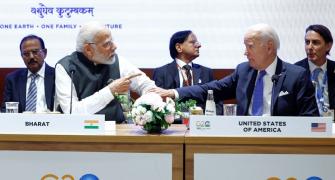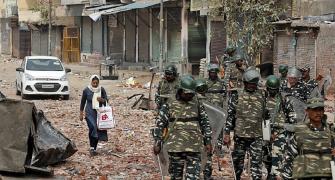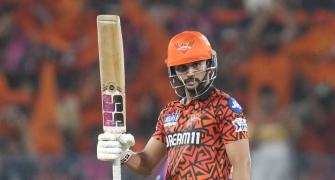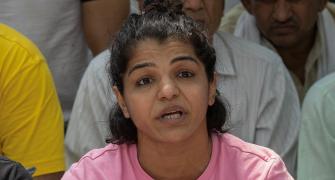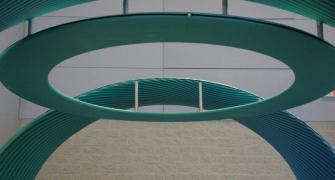High-definition televisions, offering much higher resolutions and clarity, are here. And as broadcasters convert to digital content, watching TV could be an altogether different experience.
Consider this scenario. You have just returned from office and switched on your TV -- this after working for hours on your 15- or 17-inch computer monitor. However, the images on your bigger 21-inch or 29-inch (in most cases) TV screen pale in comparison to that on your computer.
There are two reasons. The reception could be bad, which happens most of the time. The second reason (one that may not have struck you) is that since you have been sitting at your computer for very long, you have got used to the high 800x600 pixels (or the 1024x768 pixels) resolution. Your normal TV screen's resolution at 340 pixels is way below that. The higher the pixels, the sharper the images.
You may want to change all this. You may want lifelike pictures and digital sound. You may want to enhance your home theatre experience. All you need to do is walk into any major electronics shop in India and ask for a High-Definition TV or HDTV.
In all probability, the first question will be: how big is your room? The salesman will then suggest the width of the TV screen as per the size of your room. Any room that is 16 feet or more in length may do well with a 42-inch screen. In India, you have the option of settling for an LCD (Liquid Crystal Display) or a Plasma TV. The key players who sell HDTVs in India are Toshiba, Philips, Samsung, LG and Sony. Not all big screen qualify to be HDTVs, though.
At this juncture, a brief background is in order. There is a move to convert all TV sets from analogue to digital -- that is, a digital television (DTV). The digital signals might be broadcast over the air or transmitted by a cable or satellite system to your home. In your home, a decoder receives the signal and uses it, in digital form, to directly drive your digital TV set.
That 70-mm feeling: HDTV takes this a step further. It gives a higher resolution picture. Imagine 720 or 1080 lines of resolution compared to the 340 to 480 lines we are used to in India. It also comes with a wider 16:9 aspect ratio (as compared to the current 4:3). This enables wider screens and a better viewing experience. Imagine seeing more of a cricket ground or the Matrix or a cartoon film.
The formats used in HDTV are 720p -- 1280x720 pixels (p stands for progressive); 1080i -- 1920x1080 pixels (I stands for interlaced); and 1080p -- 1920x1080 pixels. "Interlaced" or "progressive" refers to the scanning system. In an interlaced format, the screen shows every odd line during the first scan, and follows that up with the even lines in a second scan.
Since there are 30 frames shown per second, the screen shows one half of the frame every 60th of a second. For smaller screens, this is passable. As screens get larger, the flicker is noticeable. Progressive scanning shows the whole picture, every line in one showing, every 60th of a second. This provides for a much smoother picture, but uses slightly more bandwidth.
Indian HDTVs are mostly of the interlaced variety since a major part of the Indian transmission network is still analogue. HDTVs require new production and transmission equipment at the HDTV stations to be taken advantage of.
It's no surprise, then, that abroad too, most of the people that bought HDTVs did so not to view HD, but rather to enjoy playing widescreen DVDs. In India, too, DVDs are getting to be HDTV quality -- they certainly display much better on a digital TV as 480p progressive scanning. The same DVD played on an analogue TV would only show the image as a 480i interlaced scanning.
Coming back to LCDs (high-end computer monitors, laptops, digital clocks, watches, microwave ovens, CD players -- LCDs are all over), they are common because are thinner and lighter and draw much less power than cathode ray tubes (CRTs -- used in your analogue TV) and Plasma TVs. However, they cannot match the size of plasma screens which can go up to 102 inches. LCD displays, though, will have a higher resolution if compared to the same plasma screens.
A 50-inch plasma TV will have a resolution of 1366x768 (true HDTV experience starts with this resolution), while a 45-inch LCD displays 1920x1080 (1080p) resolution. Those extra pixels and the production process of LCDs cost more money to produce.
Big TV, big bucks: A 26-inch HDTV (LCD) in India would cost anywhere from Rs 70,000 to Rs 85,000 depending on the brand you buy. A 32-inch LCD would come in the range of Rs 1 lakh to Rs 1.39 lakh. However, there's a big difference when you jump to the 42-inch LCD range (from Rs 2 lakh to Rs 2.30 lakh). The higher-end models could even go up to Rs 30 lakh and more.
The problem with HDTV in India is not so much with the TV sets as with the broadcasters. They will have to squeeze the increased picture detail and higher quality surround sound into the same bandwidth used by analogue television. Compression software (MPEG-2/4), very similar to what is used in personal computing, makes this possible.
We are seeing a lot of convergence happening. While it's true that most of our networks are still analogue, there's direct-to-home (DTH) and Internet Protocol TV (IPTV) making rapid inroads in the broadcasting markets.
Digital networks should become a reality in the near future, and with it will come high-definition content. You are sure to experience the full power of your HDTV. Till then, you can watch DVDs and get a bigger and better quality picture.


